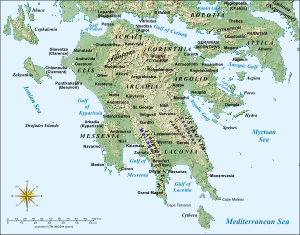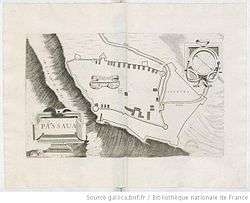Passavas
Passavas (Greek: Πασσαβάς) or Las (Λας) is a historic site situated on the Mani Peninsula.
History

In ancient times Las was a Spartan possession and in 218 BC the citizens of the city fought and routed a part of Philip V of Macedon's army. Las became part of the Union of Free Laconians in 195 BC when it separated from Sparta. The Spartans however recaptured the city in 189 BC. Sparta was then taken over by the Achaean League and Las gained its independence again. When the Romans took over most of Greece in 146 BC, Las and the other Free Laconian cities continued to be recognized as free cities. In Roman times, Las had a bath and a gymnasium.
The site is not mentioned in Byzantine times until after the Frankish conquest of the Peloponnese, when Mani was given to John of Nully, who built a castle at Las sometime after 1218. This castle became known as Passavant or Passavas in Greek, a name probably related to the motto or war-cry Passe-Avant, "move forward", or to one of the similar toponyms in northeastern France.[1] Nully's Barony of Passavant comprised four knight's fiefs, but virtually nothing is known about it.[2] It was apparently short-lived, with the castle itself falling to the Byzantines during their first offensives in the Peloponnese in ca. 1263.[3]
The castle was in use once again during the second Byzantine domination. The castle of Passavas was occupied by the Ottomans for a short time when they took over the majority of the Peloponnese, in a failed attempt to keep control over the Maniots who refused to accept Ottoman rule. In 1601, a Spanish fleet led by Alonso de Contreras that was raiding in the area surprised the Ottoman garrison and sacked the city. It was regarrisoned in 1669, by the Ottoman general Kuesy Ali Pasha. The castle was captured again in 1684 by the Venetians and the Maniots. The Venetians carried off the cannons and destroyed the city so it would not be used again. When the leader of the Maniots was executed by the Ottomans, his mother led the men of Skoutari who dressed up as priests on Easter Sunday and were allowed entry to the castle. When they got in they took out their hidden weapons and not many of the 700 families inhabiting the castle escaped. The castle was abandoned after that and has not been inhabited since.
Castle

The present castle on the site dates after the 13th century, perhaps even after the Middle Ages. It is of a quadrilateral shape, some 180 m long and 90 m wide. The castle originally featured large round towers on the northwestern, southeastern, and southwestern corners, but only the northwestern one survives. A square tower was located on the northeastern corner, the highest point of the castle; two other square towers were located in the middle of the northern and eastern walls. The wall surrounding the castle was not very tall—the chemin de ronde is barely 2 m higher than the castle's interior—and its north-eastern side is particularly feeble, as it was protected by its location on the top of the rocky hill. The entrance was probably in the south. Unidentified structures were built adjoining the walls on the interior, while during the later Ottoman occupation a mosque was built in the centre.[2]
Notes
References
- Bon, Antoine (1969). La Morée franque. Recherches historiques, topographiques et archéologiques sur la principauté d’Achaïe (in French). Paris: De Boccard.
- Livy. "Rome and the Mediterranean" ISBN 0-14-044318-5
- Peter Green. Alexander to Actium: Historical Evolution of the Hellenistic Age ISBN 0-500-01485-X
Coordinates: 36°43′39″N 22°30′16″E / 36.72750°N 22.50444°E